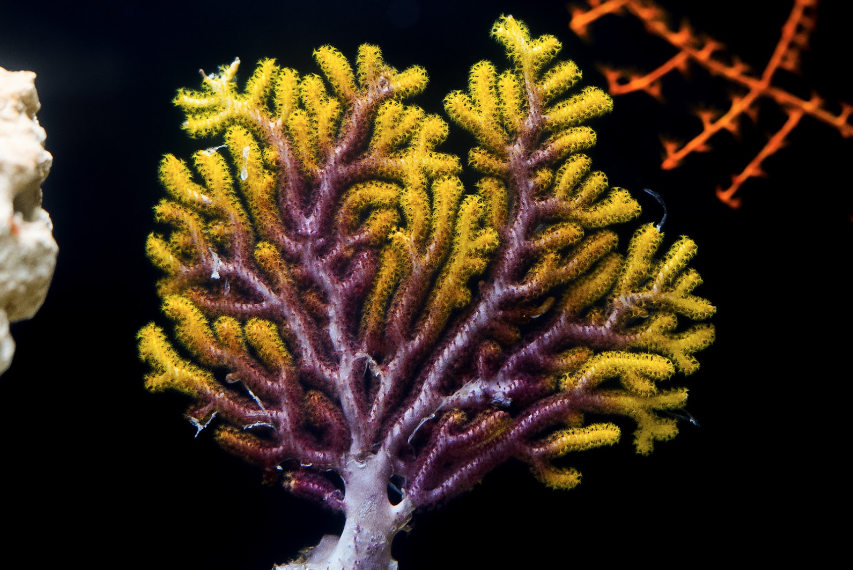Among the soft corals we keep in our tanks, we rarely see ones that exhibit multicolored polyps. Typically, aquarium specimens are mostly monochromatic, coming in varying shades of brown, green, and pink. It’s not every day that we see an octocoral like this one, especially not in captivity.
This particular octocoral, a species of Euplexaura, resides in the tank of Evan Suh, an aspiring marine biologist from the Seattle Region. Having kept aquariums since the age of seven and saltwater tanks since the age of ten, Evan has had some sort of aquatic organism in his care for about as long as he can recall. His love for nonphotosynthetic corals in particular arose from his time volunteering at the nearby Seattle Aquarium, which has a gorgeous NPS display of its own.
The first time Evan saw this species was on an Instagram post sometime last year. He quickly reached out to the owner of his local fish store who managed to procure one from ACI Aquaculture. The coral settled well into his tank and showed clear signs of growth for a few months, but ultimately it was the first casualty during a massive heat wave that affected the entire Pacific Northwest region.
Undeterred, Evan was inspired to try his hand at caring for this incredible species again and just a few months ago, managed to secure another colony from ACI Aquaculture (currently listed as an Acanthogorgia sp. on the site). His new colony is currently kept in a 29-gallon rimmed aquarium dedicated to a menagerie of unique nonphotosynthetic corals. The Euplexaura is kept at 74? in a high-flow environment directly in front of a powerhead under ambient light from a nearby window. Evan manually broadcast feeds his tank three times daily with a variety of particulate foods including Reef Nutrition Phytoplankton and Oyster Feast, which the coral seems to eagerly consume. Growth is reportedly slow, but this seems to be on par with the many members of this genus in captivity.
One phenomenon that Evan has noted was that this particular species of Euplexaura is a prolific shedder. Once a week, the colony will retract all of its polyps and adopt a glossy appearance, almost as if it were covered in a thin film of plastic. Over the next day or two, a transparent layer of “skin” will slowly peel off the coral’s branches as the polyps re-emerge. This behavior is seen in many unrelated octocoral species like Sarcophyton and Lobophytum and is believed to be a process by which the corals remove microscopic irritants like detritus and epibiotic growth. Evan has also noticed subtle growth spurts on the distal tips of the coral colony following each shedding event
Interestingly enough this particular species of Euplexaura closely resembles the bicolored appearance of the endemic Mediterranean gorgonian Paramuricea clavata which are completely unrelated to one another. These two species convergently evolved a remarkably similar phenotype despite occurring over 6,000 miles away. There is likely some underlying biological explanation for why the newer polyps and surrounding coenenchyme emerge a yellow hue before turning orange and eventually a dark red, but at the time of writing, the underlying mechanism has yet to be understood.
A colony of Paramuricea clavata, a non-photosynthetic paramuricead octocoral endemic to the Mediterranean Sea. (Image by Jean-Paul Cassez) https://www.inaturalist.org/observations/139770372
An Acanthogorgia sp. from the island reefs of New Caledonia (Image by Damien Brouste) https://www.inaturalist.org/observations/199351936
Similar species of Acanthogorgia with red and yellow polyps have also been documented from the greater Indo-Pacific region, and sometimes Euplexaura are misidentified and sold as such. One of the key differences is that Euplexaura has a thick, fleshy, coenenchyme while the coenenchyme of Acanthogorgia is hardly more than a paper-thin layer of tissue surrounding its inner gorgonin skeleton.
The Euplexaura in Evan’s tank is also home to a few tiny commensal brittle stars from the genus Ophiothela. Members of this genus are epizoic and are known to colonize dozens of different species including sponges, gorgonians, and even large sea stars. The brittle stars on Evan’s Euplexaura are likely O. mirabilis, but this species and its congeners have suffered from a troubled taxonomic history. Additionally, their high degree of variability in coloration further hinders identification. Regardless, they make for interesting additions to an already mesmerizing showpiece coral.
Evan’s Euplexaura represents a stunning example of the incredible diversity of coral species in the reef aquarium hobby. We at Reef Builders wish him the best of luck as one of the pioneers in the species’s husbandry and can’t wait to see the colony grow out.
Main image credit: A stunning Euplexaura sp. colony grown in captivity (Image by Evan Suh)
About the author
Sean Ono has been keeping corals for the better part of a decade, both at home and as a former volunteer aquarist at one of the largest public aquariums in the United States. He has a particular affinity for anthozoan cnidarians (including corals) but is passionate about echinoderms, marine worms, macroalgae, and more. Despite his familiarity with reef-associated organisms, his previous academic research is more elasmobranch-centric, aiming to quantify the biomechanical and behavioral aspects of stingray tail strikes. Having recently graduated with a Bachelor of Science in Marine Biology, Sean hopes to pursue a Ph.D. in ecology and evolution, focusing on the intersection of biomechanics, sensory capabilities, and comparative morphologies of marine taxa.



